A Guide To Wading In Salmon Rivers
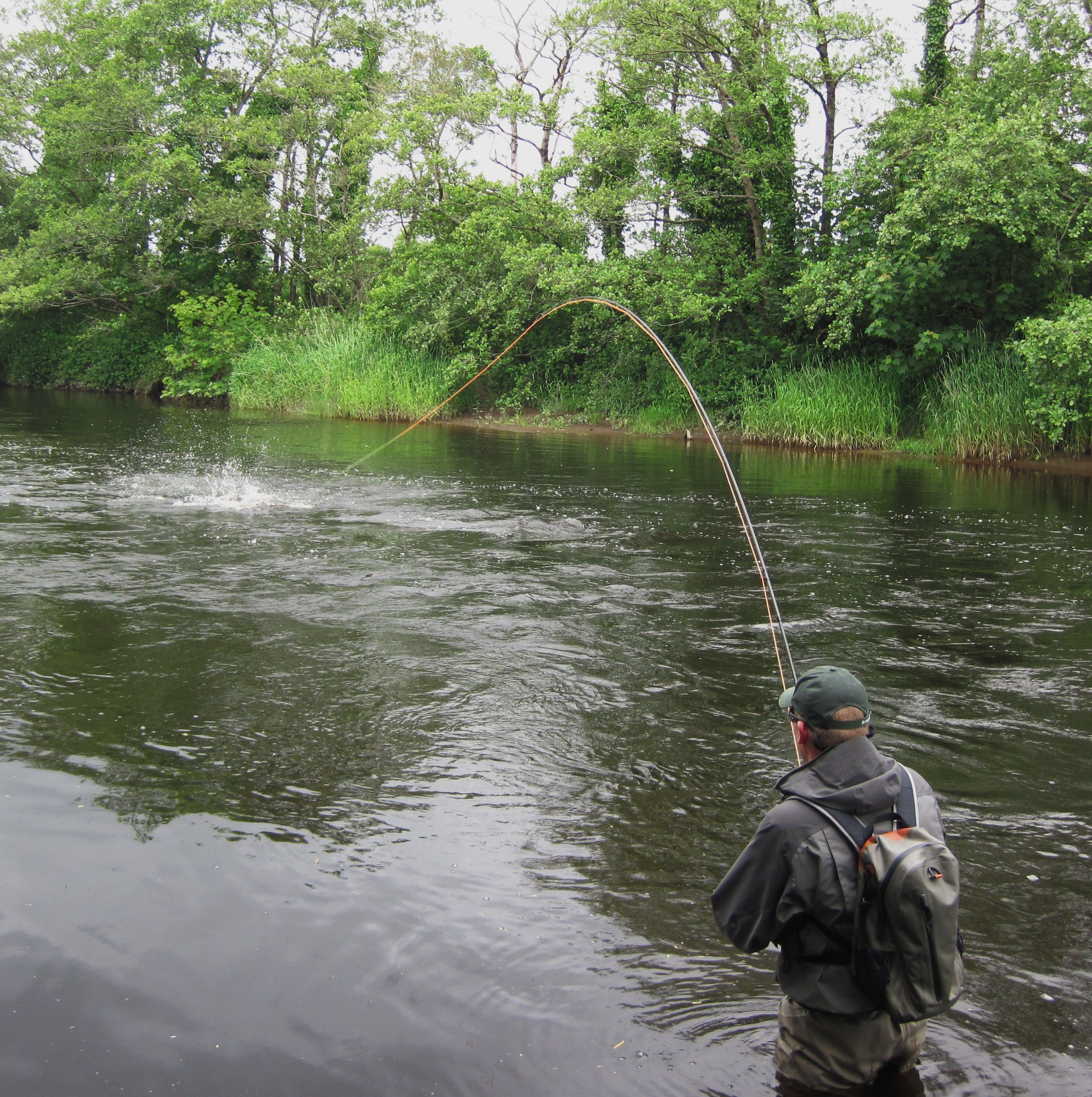
Remo Schorno hooks a nice fish
A GUIDE TO WADING IN SALMON RIVERS
The main purpose of wading when salmon fishing, is to allow us fish our flies in an effective, lifelike, and controlled way over the salmon lies. There maybe other reasons why we wade out into rivers such as, crossing over to fish from the opposite bank, providing that we can find a suitably shallow section that allows us to achieve this safely. Trying to assess the water depth or flow rate of pools in rivers that are new to us can be occasionally frustrating, but if we can find the nearest shallow area where we can safely wade at least partially,if not completely across,then this will give us a much better appreciation of the rivers average depth, and water speed. With this information logged in- our brain will subconsciously help us to evaluate/calculate depth, and current speed in other pools on that river. This little exercise might seem very simplistic, and unscientific, but our brains are super computers and with a little practice you will find this invaluable. Other reasons for wading might include such necessities as, playing a fish on a shorter line or when trying to clear our fly/fly line from some obstruction/snag.
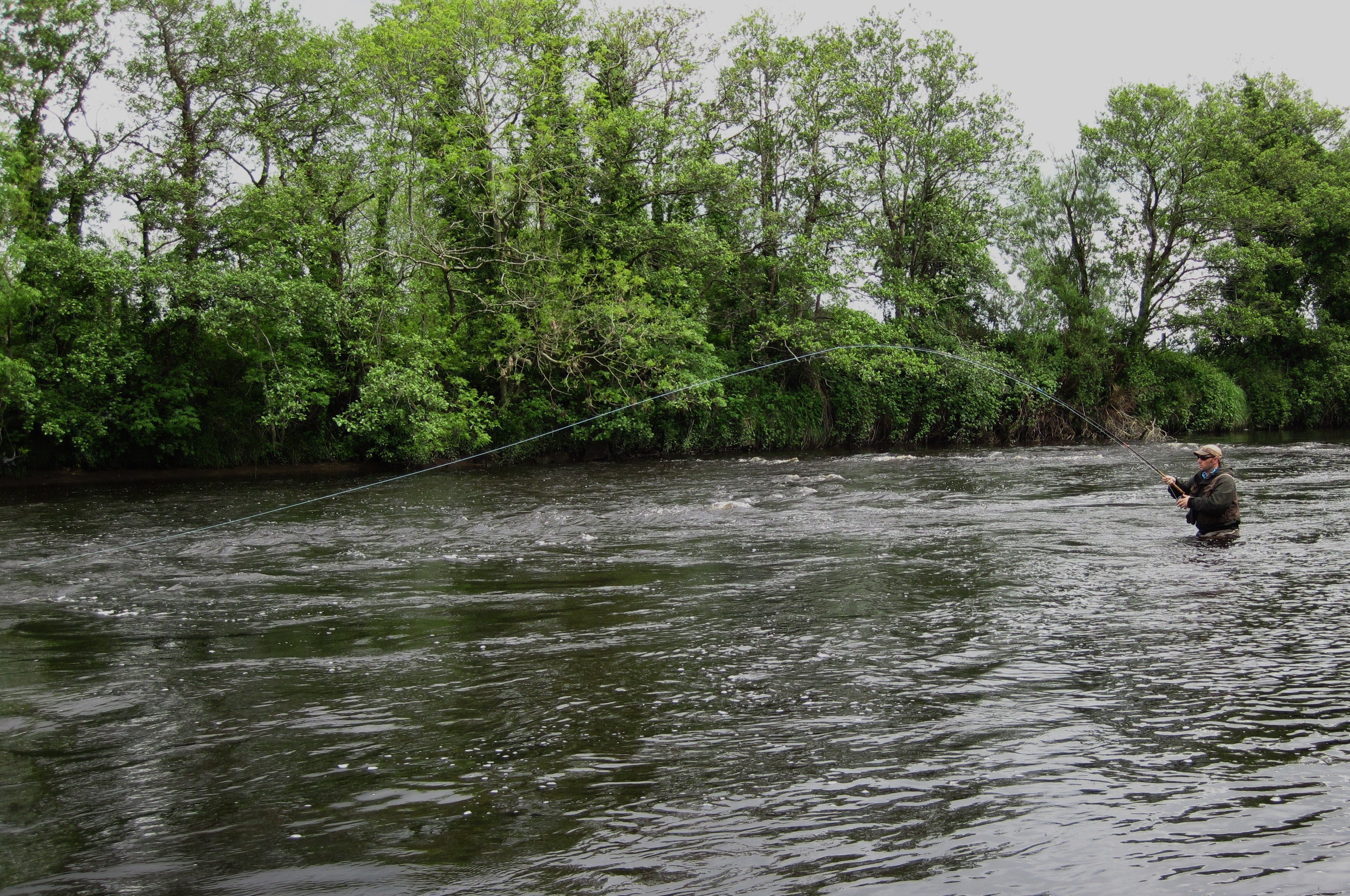
Jurgen Van den Hout decided to wade out a little more to get better control while playing a strong running grilse
One of the Golden Rules of successful salmon fishing is, never wade into a river unless absolutely necessary, as even stealthy wading causes some disturbance, and this can reduce our chances dramatically. In most salmon pools it is very likely that there will be some salmon lying on the near side of the main current, and if we wade heedlessly, or unnecessarily down this inside edge, then we run the risk of scaring these fish.This is a very common mistake especially with beginners, as many anglers seem to believe all the fish will be resting on the far side of the river. On big, wide pools it often pays to fish the near side from the bank, and only then returning to the top of the pool to wade in, and cover the fish that maybe lying from mid stream to the far side. We must try to get our fly to land beyond where the fish is lying, and sometimes it is better not to wade in, or wade in a short distance and cast a long line, rather than to wade deeply casting a shorter line. Every pool is different, and to err on the side of being over cautious is much wiser, than plunging in straight away, lashing out a long line, especially on pools that we are unfamiliar with.
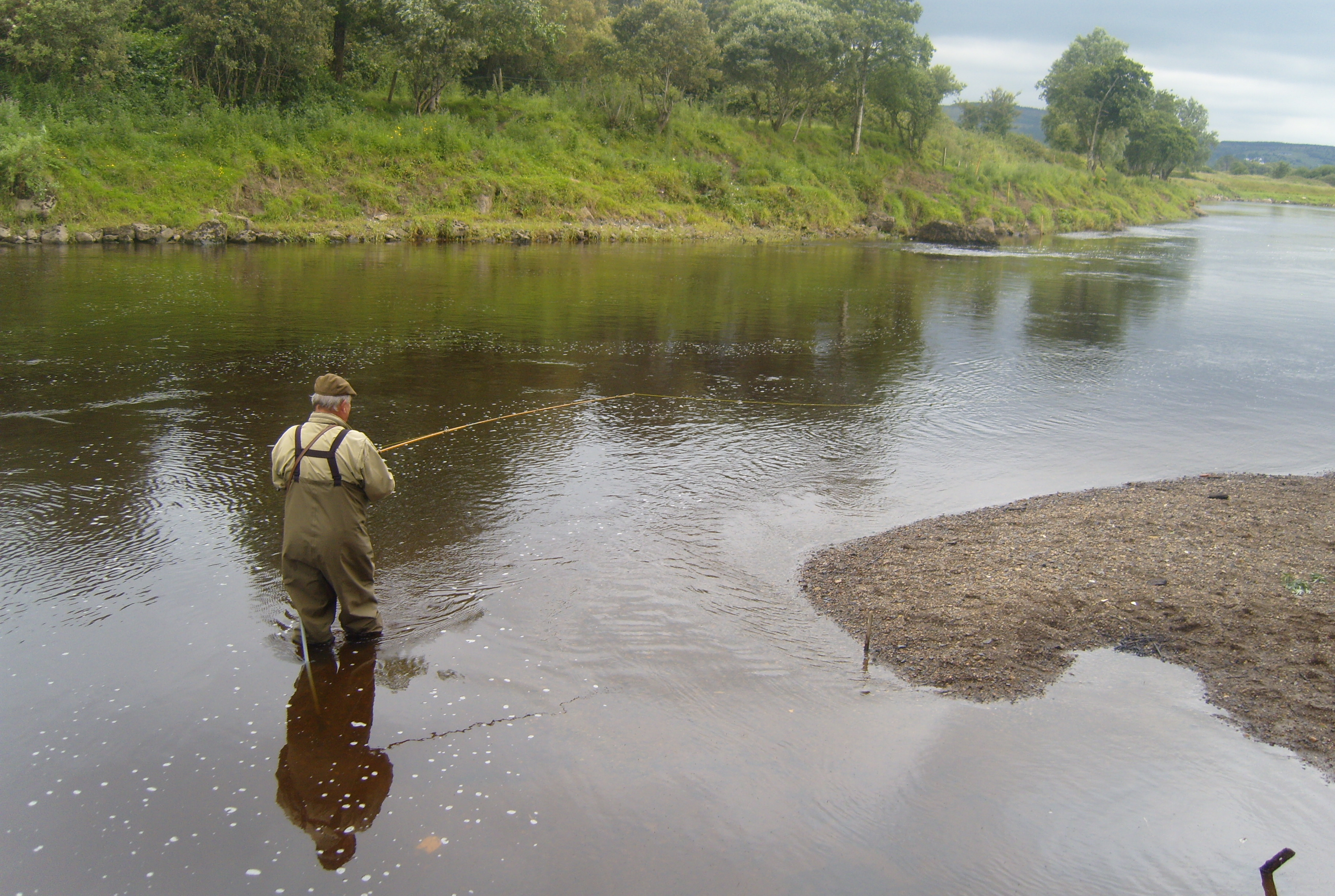
Lovely glidey fly water on the Moy with easy wading on a shingle bottomed pool. Total relaxation, no danger here, or is there?? see diagram below.
Some anglers really enjoy wading, but for many others it is a slow, tiring, and frustrating necessity, but most of all it can be dangerous for anyone who is unable to swim, and quiet often for those that can also. Wading is a major part of our overall fishing technique; however there are some pitfalls that we must be aware of when working our way down a salmon pool. The first mistake some anglers make is to try and wade to fast leaving themselves very little margin for error. One consequence of this is when they happen to kick a small boulder on the river bed with the tip of their wading boot losing balance, toppling over downstream; as their overly rapid momentum doesn’t allow them enough time to readjust their balance. Standing up on submerged, or partly submerged rocks is another common recipe for disaster, as often the river currents have gouged out deep holes on the downstream side of these rocks. Never ever clamber up on rocks while wading as getting back down again especially in a strong current flow can often be a very unnerving experience, with possibly deep water awaiting your next step downstream. Just carefully go around the obstruction and take care if you decide to go around on the outside, as this can also be unexpectedly deep. Those of us who have a poor sense of balance should work our way downstream in a sideways type of fashion, as this ensures that we have our feet placed in a more stable platform against the current, and if we happen to step into a small depression, then it is easy to readjust. Pools with shingle bottoms should be treated with great caution as it can easily happen that one can find themselves wading out on a shallow shingle spit with deep water all around until the miniature landslide of shelving shingle takes you into deep water with no way back unless you can swim.
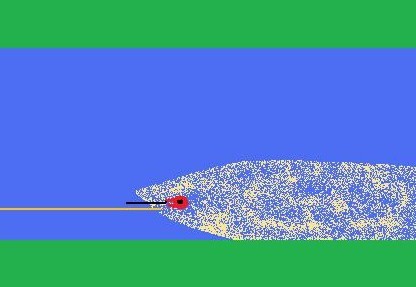
The angler, unfamiliar with this deep pool, has waded out onto this seemingly shallow shingle spit, and if he continues to wade downstream along the orange line he is going to end up swimming as the steeply sloping shingle gives way underfoot
Deep wading takes a lot of weight off the legs, and so is less tiring, that is providing the current is not too strong. Wading waist deep allows the weight of the lower half of your body to be borne by the water, and one is less likely to fall in because of the extra support gained from the water all round from your waist down. Most anglers when wading deep show more caution, moving more slowly, and this helps in reducing mishaps, in fact it is probably true to say that we get more tumbles in knee deep water, as the shallower water gives a false sense of security, and we start to speed up too much. A good little trick that we can use having lost our balance when wading deep is to quickly slap our fly rod down horizontally onto the water surface, and this will give us vital extra support for the split second it takes to regain our balance and footing.
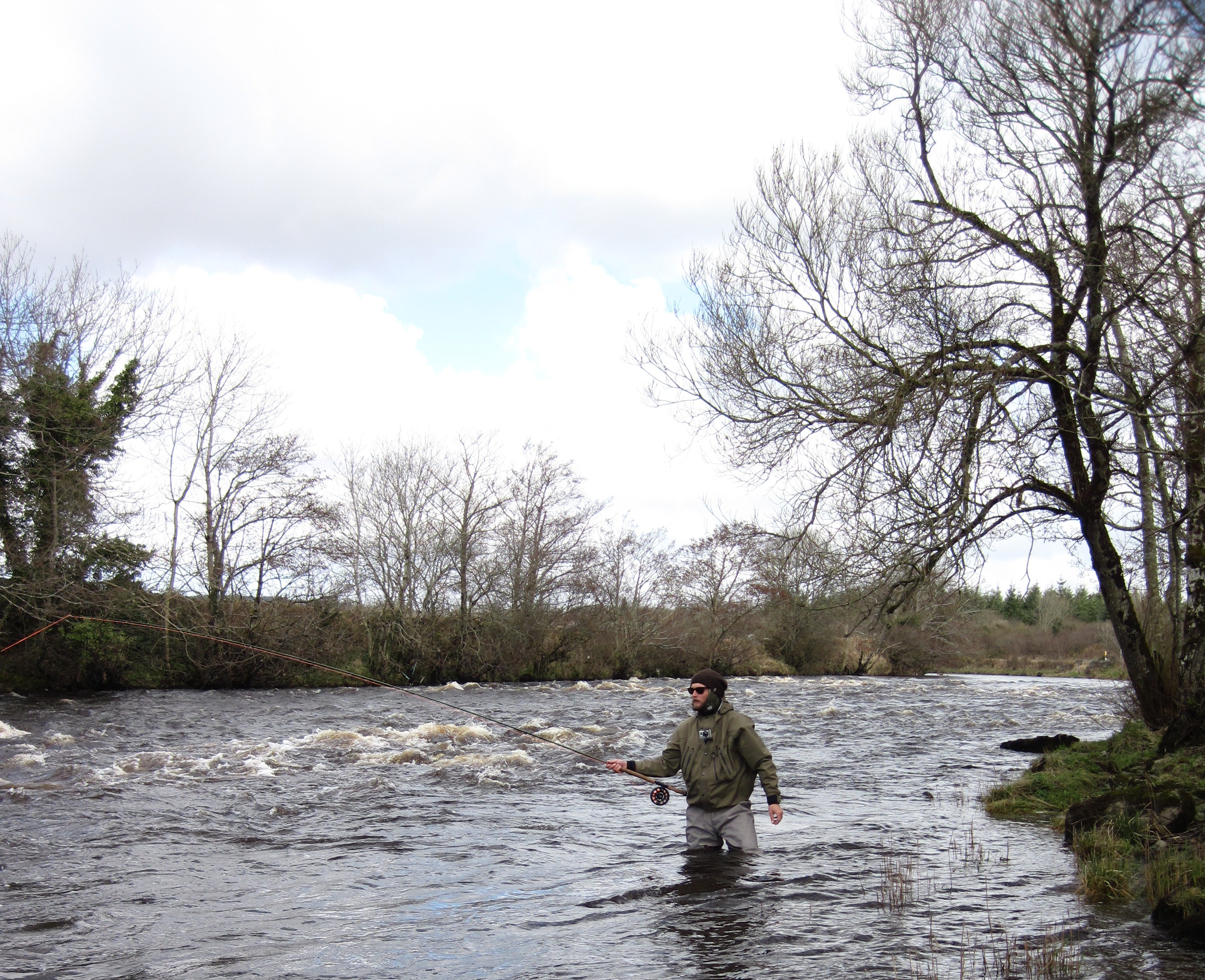
A cold spring day at Oldcastle on East Mayo Anglers Association Water river Moy. Very important to wear extra layers of warm clothes because numb legs and safe wading don’t mix.
Sometimes we can inadvertently wade too deep and because of the extra buoyancy, start to actually sort of bounce along, and this can be a nerve wrecking experience, with probable feelings of panic which we must keep under control, as our life may hang in the balance. If you find yourself in this situation and cannot swim then, try to bounce in a vertical fashion, all the time aiming yourself towards shore, and hopefully each successive bounce will bring you into shallower water as you make your way diagonally towards shore. If this fails and you find yourself under water don’t panic, keep your mouth firmly shut, there should be enough air in your lungs and trapped in your clothing to help you back to the surface. Keep your arms by your side and kick with your feet until your head breaks through the surface, try to float on your back with your arms outstretched, and your feet pointing downstream. Take a good deep breath to maximise your buoyancy, then relax and breathe as gently as possible to maintain this buoyancy, all the time looking out for a suitably shallow exit point, as you will not be able to get out along a high bank. After paddling your way into the shallows, don’t be in too much of a hurry to stand up as you will be physically weakened from your ordeal, just get on all fours and carefully and slowly get out of the water. The single most important thing to do when wading in deep and possibly dangerous water is to always wear a life jacket, let this be your number one priority. Another problem that crops up occasionally is cramp, especially for people who are susceptible to it and have been maybe wearing non breathable waders for a prolonged period during hot weather. A good antidote to cramp is salt, so for these people it would be wise to carry a few salt tablets in their wading jackets.
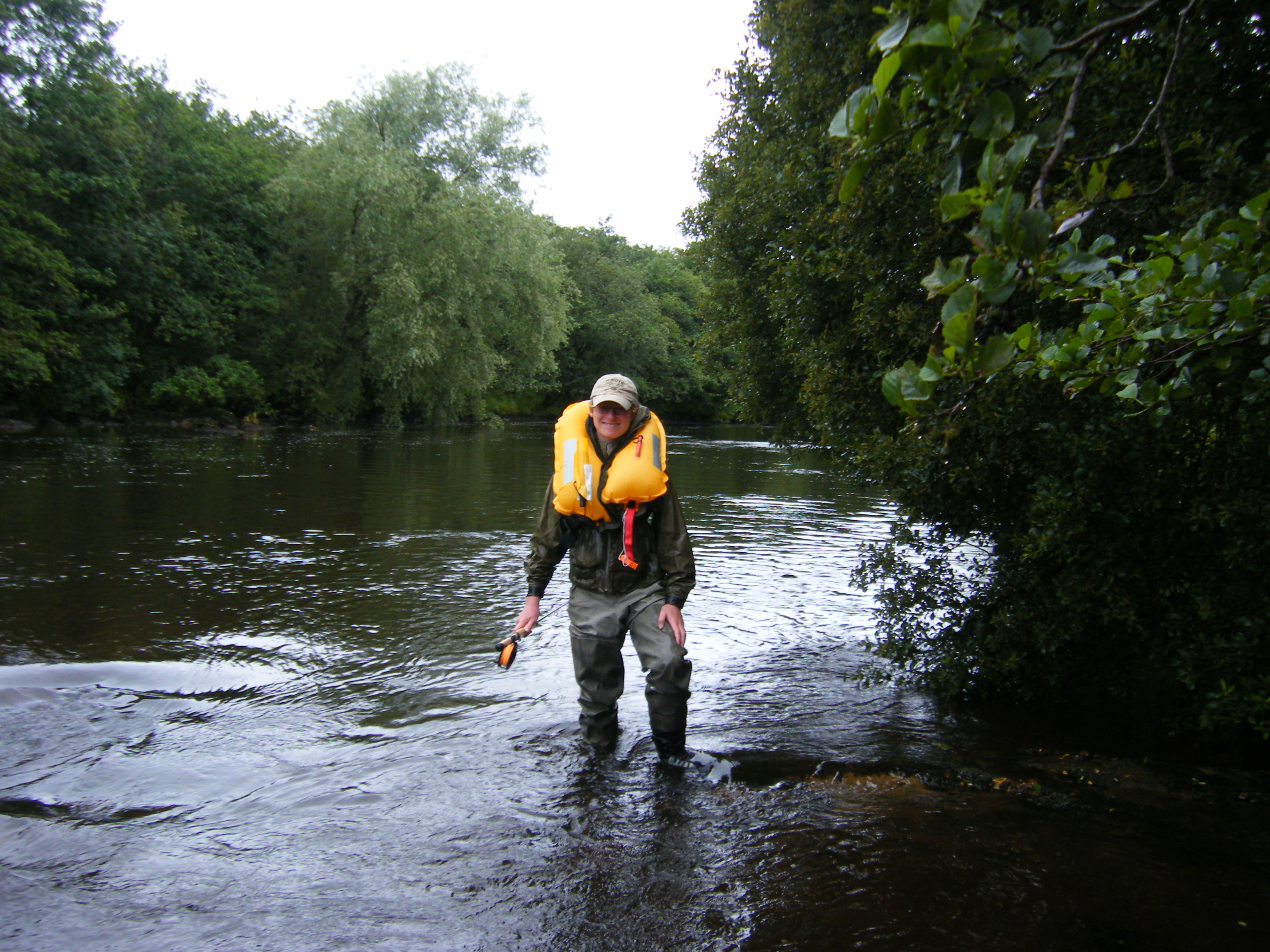
This young angler had a minor mishap, but was wisely wearing his life jacket and after a quick change of clothing was back enjoying his fishing once again
A wading stick is a great asset for those that are a little apprehensive about venturing out in a fast current, and by the way a little fear and respect for fast flowing streams is no bad thing. There are some super hero style waders out there that could do with a little fearfulness, but sooner, or later all these risk takers end up swimming, and hopefully they will survive to learn from their foolishness. Most wading sticks have lead added at their ends to stabilise them in the water, just check that when purchasing one that there is sufficient lead incorporated, as many of the sticks that I have seen don’t have enough ballast and lay flat in the water instead of standing upright beside the angler. Care must be taken when attaching cords to our wading sticks. The end of the cord must be attached to the wading stick using a quick release knot/system, because if the fly fisher falls in the cord must break away easily, otherwise there is the very real risk that the wading stick may anchor, or snare its unfortunate victim. Another thing to watch out for when attaching the cord to our body is that we don’t hinder in any way the proper inflation of our life jacket.
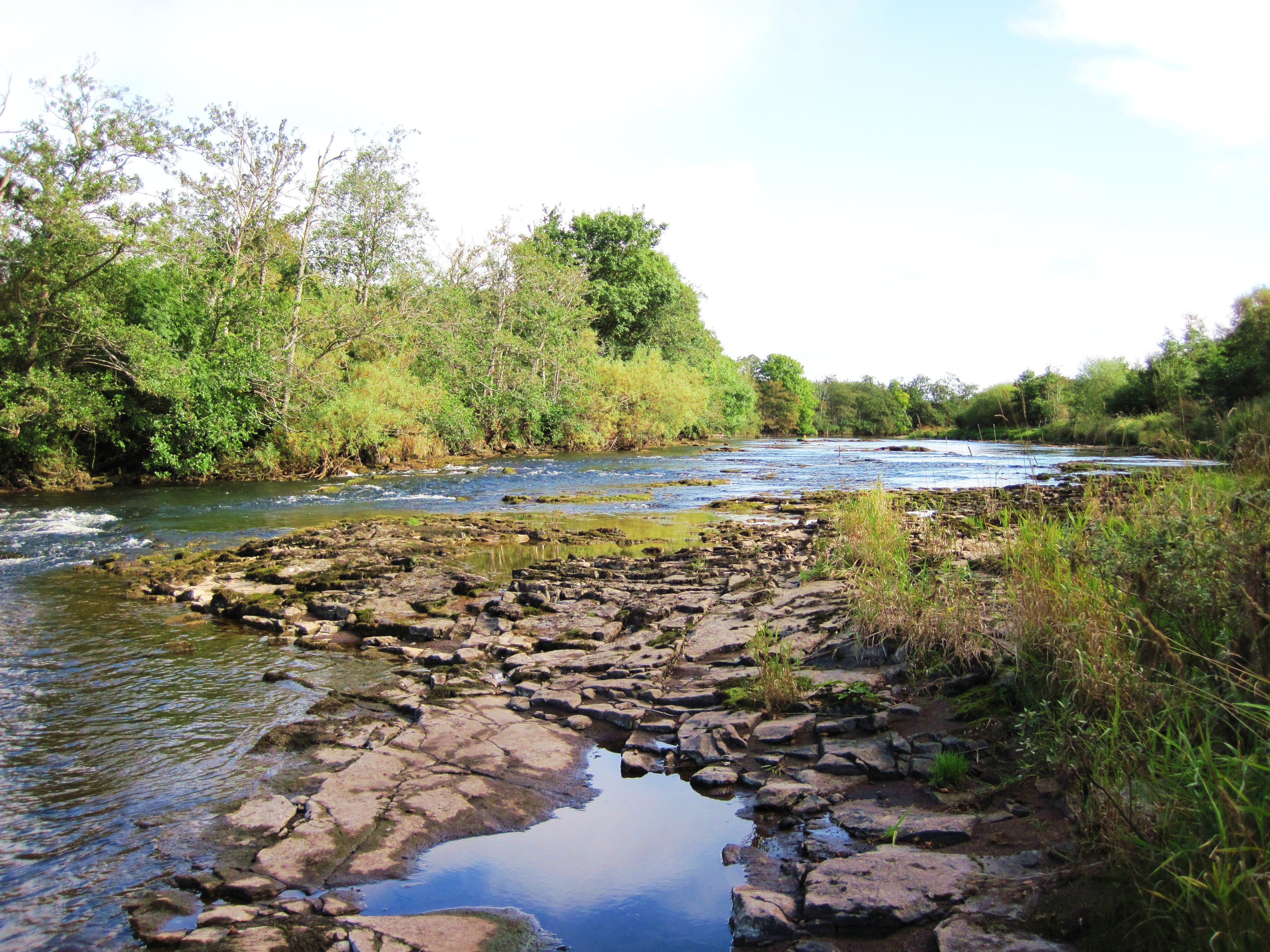
A really good way to learn about possible wading dangers in your favorite river is to go on a scouting mission in low water conditions.
If you are wading in a strong current without a wading staff, and are a little worried, don’t be afraid to wind up your line and use your rod as a makeshift wading stick, this has saved many lives down through the years. River beds can vary from fine pebbles all the way up to huge boulder strewn death traps, and when choosing wading boots it is important to get ones with felt soles, or felt in combination with metal studs, as these give us maximum grip, but be very aware because these very boots that give us such a good grip on slippery rocks while wading, are absolutely deadly dangerous on wet grass and muddy river side banks. Keep a backup change of clothes in your car along with some towels, and if possible a flask of hot drink. After a wetting in the river don’t be tempted to accept a drink of whisky or brandy from a well meaning friend, as all it will do is lower your body temperature further, leave it until later when all the boys are having a good laugh in the pub!!!
The most important thing to remember is, SAFETY FIRST, at all times. Our families and friends expect nothing less from us.
Tight lines

Cheers Paddy another great article. Keep them coming.
Just out of curiosity where was that photo taken on the joy with the glidey water with the shingle bottomed pool?
Hi Richie, the pool is Gurteen on the Fopxford Fishery just below Foxford town
I’d like to find out more? I’d like to find out more details.
Just email me with any questions that you may have
Terrific post however I was wondering if you could write a
litte more on this subject? I’d be very thankful if you could elaborate a little bit further.
Thank you!
I hope to upload many more fishing articles in the near future
very informative paddy,i will make sure paul chew has a read
Thanks Danny
Hello There. I discovered your weblog the use of msn. That is an extremely neatly written article.
I’ll make sure to bookmark it and return to learn more of your useful
info. Thanks for the post. I’ll certainly return.